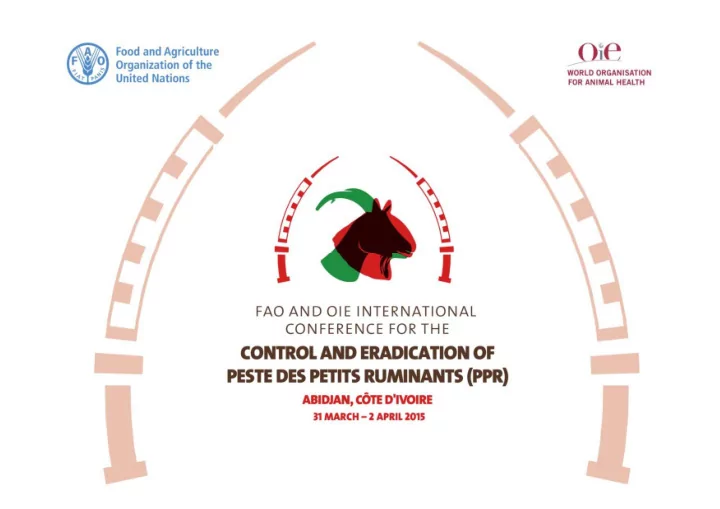

Felix Njeumi, FAO Susanne Münstermann, OIE Members of the PPR working group Surveillance tools and methods including field surveillance and national, regional and international Networks
Introduction • Surveillance is a key element of the GCES and more specifically its strategic approach, based on 4 different stages of the global strategy. • Surveillance systems are one of the 5 technical elements characterising each stage of the GCES Diagnostic systems Surveillance systems Prevention and control Legal framework Stakeholders • Surveillance is key to understand the PPR epidemiology in a county and to monitor progress in the control and eradication efforts • Surveillance systems become more complex along the progression along the 4 stages
Objectives of the surveillance Early warning/detection Prevalence and distribution of the Information disease/infection planning and research Demonstrate the absence of clinical disease Identify priority Assessment of areas for health situation control/prevention
Epi network • National focal point, regional network in each region coordinated by the global network • Networks are essential forum for the discussion and analysis of disease status data and the exchange of information, • Link with reference laboratories for confirmatory diagnosis, vaccines QC and sustained surveillance programmes, • Stakeholders & their roles • Trainings, workshops, Reporting and IT systems in place
Methodology - general Along the stages of the GCES, the use of different surveillance methods vary. No Stage title Stage objective Surveillance method Active Passive 1 Assessment Epi situation: absence +++ + or presence of PPRV PVE 2 Control Implementation of ++ ++ targeted control strategy 3 Eradication Nation-wide control & ++ +++ eradication program 4 Post- Evidence that no + ++++ eradication PPRV is circulating
Active surveillance Stage Passive surveillance Stage s s Serology 1,4 Clinical / syndromic 1,2,3 Abattoir (specific surveys) 1,2 Abattoir (reported cases) 2,4 Wildlife (as sentinels) 2,3 Wildlife (reported cases) 2,3,4 Markets (specific surveys) 1,2,3 Markets (reported cases) 2,3,4 Border VS post inspection 3,4 Border VS post inspection 3,4 surveys reports Participatory disease search 1,2,3 Questionnaire surveys 1,2 Reporting systems from 1,2,3,4 veterinary/ para-vet networks
Sero-surveillance • Target population all susceptible small ruminants in a particular location at risk of PPR. • Study population the population included in the surveillance programme Can be stratified by AGE and HUSBANDRY SYSTEM • Case definition presence of PPR virus or specific antibodies against PPR virus antigens is demonstrated in susceptible species (Art. 14.7.1 TAHC) • Epi unit All small ruminants have the same chance of being infected with PPR virus. (could be the flock/herd or village)
Methodology - specific • Surveillance method (a guide, to be adapted to local situation) Assumption: in case of incursion of PPR virus: 5% of epi units infected and 30% of individual animals within each epi unit infected two-stage sampling: o first stage: the epi unit o second stage: individual animals within the selected epi units.
Methodology – specific cont. • Sample size at epi unit level Sample size for animals Number of Epi Unit Sample size Number animals in Sample size 0 ‐ 25 All epi unit 26 ‐ 30 26 1 – 6 All 31 ‐ 40 31 41 ‐ 50 35 7 ‐ 10 6 51 ‐ 70 40 11 – 25 7 71 ‐ 100 45 26 – 55 8 101 ‐ 200 51 201 ‐ 1200 57 >56 9 >1200 59 5% prevalence at epi unit 30% prevalence at animal level level
Implementation • Training of field officers (Gov & CAHW) on a number of essential subjects • Logistics • Close collaboration with laboratories, short turn- around time, good communication laboratory to field • Budget • Cooperation with national and regional Epi networks for harmonised surveillance protocols
Conclusion • Surveillance is key to the implementation and ultimate success of the GCES • Regional and international epi and laboratory networks, as envisaged in the GCES are essential in supporting the implementation of a successful surveillance program at national level • Differentiation of sero-surveillance from post- vaccination evaluation
Thank you PPR WORKING GROUP Felix.njeumi@fao.org; s.munstermann@oie.int
Recommend
More recommend